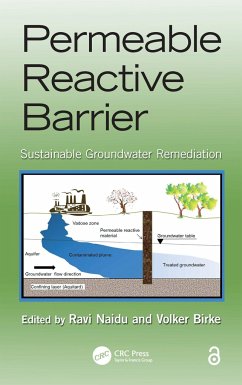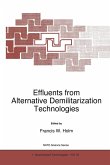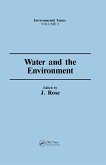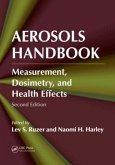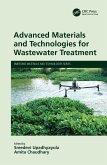Permeable Reactive Barrier
Sustainable Groundwater Remediation
Herausgeber: Naidu, Ravi; Birke, Volker
Permeable Reactive Barrier
Sustainable Groundwater Remediation
Herausgeber: Naidu, Ravi; Birke, Volker
- Gebundenes Buch
- Merkliste
- Auf die Merkliste
- Bewerten Bewerten
- Teilen
- Produkt teilen
- Produkterinnerung
- Produkterinnerung
With contributions from pioneers in this area, this book covers state-of-the-art information on PRB technology. It details design criteria, predictive modeling, and application to contaminants beyond petroleum hydrocarbons, including inorganics and radionuclides.
Andere Kunden interessierten sich auch für
![Multifunctional Cement-Based Materials Multifunctional Cement-Based Materials]() Deborah D L ChungMultifunctional Cement-Based Materials179,99 €
Deborah D L ChungMultifunctional Cement-Based Materials179,99 €![Effluents from Alternative Demilitarization Technologies Effluents from Alternative Demilitarization Technologies]() HolmEffluents from Alternative Demilitarization Technologies179,99 €
HolmEffluents from Alternative Demilitarization Technologies179,99 €![Water and the Environment Water and the Environment]() J. RoseWater and the Environment472,99 €
J. RoseWater and the Environment472,99 €![Aerosols Handbook Aerosols Handbook]() Aerosols Handbook294,99 €
Aerosols Handbook294,99 €![Advanced Materials and Technologies for Wastewater Treatment Advanced Materials and Technologies for Wastewater Treatment]() Advanced Materials and Technologies for Wastewater Treatment190,99 €
Advanced Materials and Technologies for Wastewater Treatment190,99 €![Transition Engineering Transition Engineering]() Susan KrumdieckTransition Engineering137,99 €
Susan KrumdieckTransition Engineering137,99 €![Effluents from Alternative Demilitarization Technologies Effluents from Alternative Demilitarization Technologies]() HolmEffluents from Alternative Demilitarization Technologies116,99 €
HolmEffluents from Alternative Demilitarization Technologies116,99 €-
-
-
With contributions from pioneers in this area, this book covers state-of-the-art information on PRB technology. It details design criteria, predictive modeling, and application to contaminants beyond petroleum hydrocarbons, including inorganics and radionuclides.
Produktdetails
- Produktdetails
- Verlag: CRC Press
- Seitenzahl: 333
- Erscheinungstermin: 1. Dezember 2014
- Englisch
- Abmessung: 234mm x 163mm x 23mm
- Gewicht: 680g
- ISBN-13: 9781482224474
- ISBN-10: 148222447X
- Artikelnr.: 40554898
- Verlag: CRC Press
- Seitenzahl: 333
- Erscheinungstermin: 1. Dezember 2014
- Englisch
- Abmessung: 234mm x 163mm x 23mm
- Gewicht: 680g
- ISBN-13: 9781482224474
- ISBN-10: 148222447X
- Artikelnr.: 40554898
Professor Ravi Naidu is the chief executive and managing director of the Cooperative Research Centre for Contamination Assessment and Remediation of the Environment. He has researched environmental contaminants, toxicology, bioavailability, and remediation for over 20 years. Ravi has co-authored over 500 technical publications and co-edited 10 books in the field of soil and environmental sciences including field remediation of contaminated sites. His current research focuses on the remediation of contaminated soil, water and potential impacts of contaminants to environmental and human health. Dr. Volker Birke has around 25 years of experience in organic and environmental chemistry, particularly in green chemistry, the destruction of hazardous wastes and toxic compounds in the environment. He has experience in remediation of contaminated sites, hazardous waste management, and especially ground water remediation, with 12 years as coordinator of the large-scale German R&D program "RUBIN" for the application of permeable reactive barriers (PRBs) to ground water pollution, 25 years in the development and application of innovative ex situ and in situ remediation technologies to persistent organic pollutants (POPs), particularly mechanochemical dehalogenation (MCD) regarding ex situ treatment, as well as innovative ground water remediation technologies such as PRBs or nano and micro scale reactive particles for in situ treatment of polluted ground water. Another focus covers environmental analytics, especially regarding POPs such as polychlorinated biphenyls (PCBs) or dibenzodioxins (PCDD). He has been senior scientist, project leader, and senior lecturer in environmental chemistry and engineering at the Faculty of Civil and Environmental Engineering at the Ostfalia University of Applied Sciences, Campus Suderburg, Germany, since 2000. Since 2009, he has been commissioned to administer the professorship of chemistry at the faculty. He teaches the management of contaminated sites, remediation technologies, chemistry, physics, and mathematics for engineers and environmental scientists as well as occupational health and safety, with a focus on special applications and requirements for working in areas contaminated by hazardous compounds and at polluted sites. Dr. Birke has been involved in the management of about 50 remedial investigations, remedial designs and clean-up of polluted sites in Germany as well as abroad (Europe, the United States, India, Australia). He received a PhD in organic chemistry from the University of Hanover. Dr. Birke has published about 50 papers focusing on innovative ex situ and in situ remediation technologies such as mechanochemical dehalogenation and PRBs and is the main author of one book on remediation of contaminated sites using PRBs in Germany.
Permeable Reactive Barriers- cost-effective and sustainable remediation of
groundwater. Two Decades of Application of Permeable Reactive Barriers to
Groundwater Remediation. CHOOSING THE BEST DESIGN AND CONSTRUCTION
TECHNOLOGIES FOR PERMEABLE REACTIVE BARRIERS. Ground Water Modelling
Involving PRBs - General Aspects, Case Studies. Impact of Trace Elements
and Impurities In Technical Zero Valent Iron Brands On Reductive
Dechlorination of Chlorinated Ethenes in Ground Water. Fourteen-year
Assessment of a Permeable Reactive Barrier for Treatment of Hexavalent
Chromium and Trichloroethylene. Sequenced Permeable Reactive Barrier for
the Pre-Treatment of Nitrate and Remediation of Trichloroethene. ORGANIC-
BASED PERMEABLE REACTIVE BARRIERS FOR THE TREATMENT OF HEAVY METALS,
ARSENIC AND ACIDITY. Effective Cleanup of Groundwater Contaminated with
Radionuclides Using Permeable Reactive Barriers. Reactive (Oxygen) Gas
Barrier and Zone Technologies. The Remediation of PAHs, NSO-Heterocycles
and Related Aromatic Compounds in Permeable Reactive Barriers using
Activated Carbon. Case study of PRB application for the remediation of
ground water. PERMEABLE REACTIVE BARRIERS IN EUROPE.
groundwater. Two Decades of Application of Permeable Reactive Barriers to
Groundwater Remediation. CHOOSING THE BEST DESIGN AND CONSTRUCTION
TECHNOLOGIES FOR PERMEABLE REACTIVE BARRIERS. Ground Water Modelling
Involving PRBs - General Aspects, Case Studies. Impact of Trace Elements
and Impurities In Technical Zero Valent Iron Brands On Reductive
Dechlorination of Chlorinated Ethenes in Ground Water. Fourteen-year
Assessment of a Permeable Reactive Barrier for Treatment of Hexavalent
Chromium and Trichloroethylene. Sequenced Permeable Reactive Barrier for
the Pre-Treatment of Nitrate and Remediation of Trichloroethene. ORGANIC-
BASED PERMEABLE REACTIVE BARRIERS FOR THE TREATMENT OF HEAVY METALS,
ARSENIC AND ACIDITY. Effective Cleanup of Groundwater Contaminated with
Radionuclides Using Permeable Reactive Barriers. Reactive (Oxygen) Gas
Barrier and Zone Technologies. The Remediation of PAHs, NSO-Heterocycles
and Related Aromatic Compounds in Permeable Reactive Barriers using
Activated Carbon. Case study of PRB application for the remediation of
ground water. PERMEABLE REACTIVE BARRIERS IN EUROPE.
Permeable Reactive Barriers- cost-effective and sustainable remediation of
groundwater. Two Decades of Application of Permeable Reactive Barriers to
Groundwater Remediation. CHOOSING THE BEST DESIGN AND CONSTRUCTION
TECHNOLOGIES FOR PERMEABLE REACTIVE BARRIERS. Ground Water Modelling
Involving PRBs - General Aspects, Case Studies. Impact of Trace Elements
and Impurities In Technical Zero Valent Iron Brands On Reductive
Dechlorination of Chlorinated Ethenes in Ground Water. Fourteen-year
Assessment of a Permeable Reactive Barrier for Treatment of Hexavalent
Chromium and Trichloroethylene. Sequenced Permeable Reactive Barrier for
the Pre-Treatment of Nitrate and Remediation of Trichloroethene. ORGANIC-
BASED PERMEABLE REACTIVE BARRIERS FOR THE TREATMENT OF HEAVY METALS,
ARSENIC AND ACIDITY. Effective Cleanup of Groundwater Contaminated with
Radionuclides Using Permeable Reactive Barriers. Reactive (Oxygen) Gas
Barrier and Zone Technologies. The Remediation of PAHs, NSO-Heterocycles
and Related Aromatic Compounds in Permeable Reactive Barriers using
Activated Carbon. Case study of PRB application for the remediation of
ground water. PERMEABLE REACTIVE BARRIERS IN EUROPE.
groundwater. Two Decades of Application of Permeable Reactive Barriers to
Groundwater Remediation. CHOOSING THE BEST DESIGN AND CONSTRUCTION
TECHNOLOGIES FOR PERMEABLE REACTIVE BARRIERS. Ground Water Modelling
Involving PRBs - General Aspects, Case Studies. Impact of Trace Elements
and Impurities In Technical Zero Valent Iron Brands On Reductive
Dechlorination of Chlorinated Ethenes in Ground Water. Fourteen-year
Assessment of a Permeable Reactive Barrier for Treatment of Hexavalent
Chromium and Trichloroethylene. Sequenced Permeable Reactive Barrier for
the Pre-Treatment of Nitrate and Remediation of Trichloroethene. ORGANIC-
BASED PERMEABLE REACTIVE BARRIERS FOR THE TREATMENT OF HEAVY METALS,
ARSENIC AND ACIDITY. Effective Cleanup of Groundwater Contaminated with
Radionuclides Using Permeable Reactive Barriers. Reactive (Oxygen) Gas
Barrier and Zone Technologies. The Remediation of PAHs, NSO-Heterocycles
and Related Aromatic Compounds in Permeable Reactive Barriers using
Activated Carbon. Case study of PRB application for the remediation of
ground water. PERMEABLE REACTIVE BARRIERS IN EUROPE.

